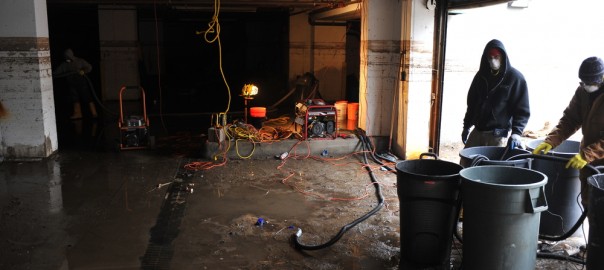The First Critical Steps to Take After a Basement Flood

For the unprepared, basement floods can be overwhelming to deal with. Since basements are underground there isn’t anywhere for the flood water to drain out. The longer stagnant flood water is left to stew in your basement, the higher the chances of the water weakening the structural integrity of the building. What’s more, if you don’t act quickly to find the source of the water, the flood could spread to other levels of the property. If you are a victim of a basement flood, there are a few critical steps you need to take right away:
1. Change into Protective Clothing
Flood waters are often riddled with diseases. Protect yourself from ecoli, mold, and other harmful bacteria and toxins lurking in the flooded area with waterproof gloves, rubber overalls, waterproof boots, a mask, goggles and a hooded long sleeve top are a good place to start.
2. Shut Off The Power
We all know water and electricity is a very dangerous combination. If you enter a flooded area without shutting off the power you risk electrocuting yourself and others. If you have no way of reaching the circuit board without endangering yourself consult an electrician.
3. Pinpoint the Cause of the Flooding
Once you are able to enter the basement safely, you will need to find the source of the flooding. When you have pinpointed the leak assess whether or not you can apply a stopper yourself, or if a plumber needs to be called.
4. Gather Buckets and Other Tools to Start the Preliminary Clean Up
You’ll need buckets for carrying out water, and chisels and hammers for removing damaged drywall. However, to avoid any mishaps or further damage to your property, contact a professional cleaning service. They will be able to take care of any debris, the flood water and disinfecting the room.
5. Assess the Damage
Next, you’ll need to inspect the damage to your property, including any furniture, walls, flooring, and the foundation of you basement. Make a detailed list of all of the damage you can see. Be sure to take pictures that clearly show the damage areas. These pictures and your notes will come in handy when speaking to your insurance company.
6. Call Your Insurance Provider
When you call your insurance provider to report the flooding it is most likely that an insurance agent will be sent to your home to inspect the damage. This is a good time to present your notes and your pictures. Make sure to ask for a copy of the agent’s notes as well.
7. Beginning the Restoration Process
The mental and financial strain of restoring a flooded basement can take a toll. While some of the restoration work you may be able to accomplish on your own, depending on the severity of the damage, restoration experts may need to be brought in. Keep this in mind when beginning the restoration process.



